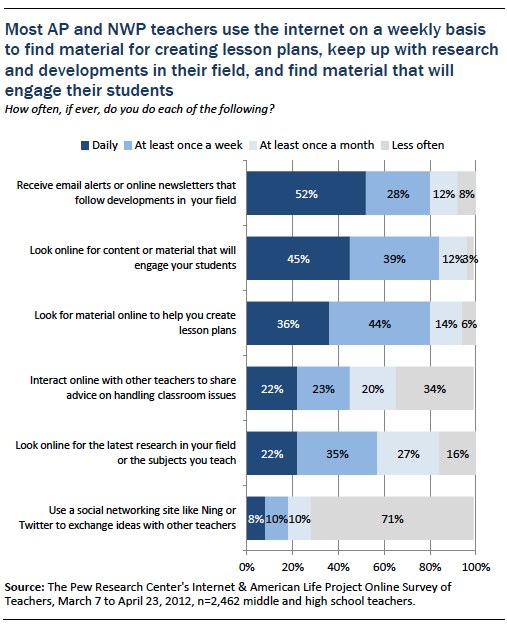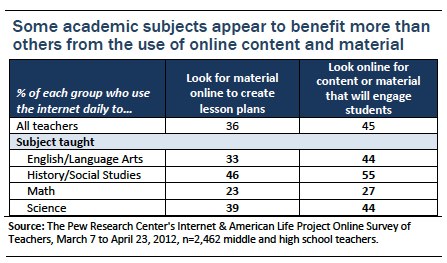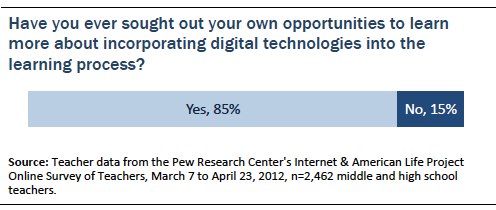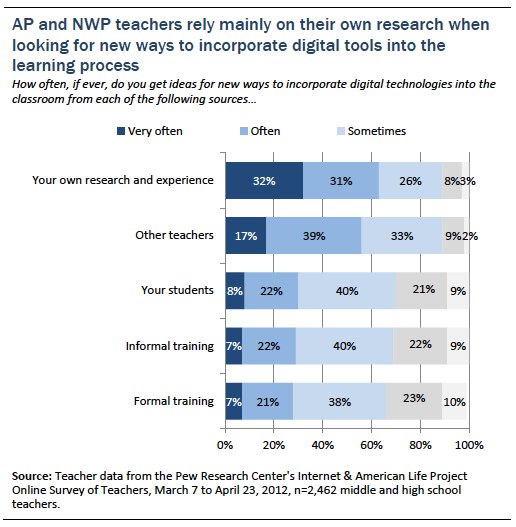The AP and NWP teachers in this study not only use digital tools in an effort to improve the learning experience for students, but also use these tools in their own training, development, and professionalization. For most, the greatest impact of the internet and other digital tools on their role as teachers has been access to more content and material for use in the classroom and a greater ability to keep up with developments in their field. To a slightly lesser extent, these teachers use digital tools to share ideas and experiences with other teachers. In terms of professional support and training in how best to use new digital tools in their classrooms, the vast majority of these teachers are satisfied with the support and training schools provide. At the same time, most say they rely mainly on their own research and experience when developing new ways of bringing technology to the learning process.
AP and NWP teachers say the internet and other digital tools have had mixed impacts in shaping the lives of educators
Asked about potential impacts the internet and digital tools might have on teachers, these AP and NWP teachers see both benefits and potential downsides. The greatest impact they see is increased access to content, resources and materials for their teaching; 92% of these teachers say the internet has had a “major impact” in this regard. At the same time, three-quarters of these teachers say the internet and other digital tools have had a “major impact” on the range of content and skills they must be knowledgeable about. Just over two-thirds note “major impact” on their ability to share ideas with other teachers and enabling interaction with parents.
Another area where impact is felt is in the sheer amount of work required from teachers. This theme emerged in focus groups, where some noted feeling responsible today for not only subject matter expertise, but also expertise in the latest tech gadgets. In the full survey of AP and NWP teachers, 41% say they have felt a “major impact” in this area and another 42% say they feel a “minor impact.” Thus, more than eight in 10 AP and NWP teachers have felt some increase in workload as the internet and other digital tools become a greater part of the learning process.

The degree to which AP and NWP teachers feel the impact of the internet on these elements of their professional lives is surprisingly consistent across most subgroups. Among the few notable differences that emerge are in the degree to which digital tools have impacted teacher/parent interaction, with teachers of higher income students more likely than those teaching the lowest income students to say the internet and digital technologies have had a major impact in this area. While 75% of teachers of the highest income students feel a “major impact” in this area, the same is true of just 55% of teachers of the lowest income students.
Another impact where some variation is seen is the degree to which the internet and other digital technologies have increased the range of content and skills teachers feel they must be knowledgeable about. While 78% of English teachers feel a “major impact” in this area, that figure is 71% among Science teachers and 66% among math teachers. Similarly, while 81% of teachers in rural areas and 78% of teachers in urban areas feel the internet has had a “major impact” on the range of topics they must master, slightly fewer suburban (73%) and small town (73%) teachers feel the same way. There is almost no variation on this item across teachers of different ages or different levels of experience.
One might expect more experienced teachers to be more inclined to feel the internet and other digital tools have generally increased their workload as teachers. While this is true among these AP and NWP teachers, the difference between more and less experienced teachers is small. While 45% of those who have been teaching 16 years or more feel the internet has had a “major impact” on their overall workload, the same is true of 37% of teachers who have spent fewer years in the classroom.
The majority of AP and NWP teachers use the internet on a weekly basis to keep up with developments in their field and to find material they can use in lesson plans
Asked how often they use the internet for a variety of work-related tasks, a large majority of AP and NWP teachers (80%) report getting email alerts at least weekly that allow them to follow developments in their field, including 52% who say this happens daily. A majority also use the internet at least weekly to find content that will engage students (84%) or material to help them create lesson plans (80%). In contrast, just 18% say they use a social networking site on a weekly basis to exchange ideas with other teachers.

As is the case with the use of collaborative online tools, it appears that using the internet to find material online to create lesson plans or engage students is more useful for some academic subjects than others. History/social studies teachers are most likely to say they use the internet daily for each of these tasks, while math teachers are the least likely. In both cases, history/social studies teachers are twice as likely as math teachers to use the internet as a resource for content.

Most AP and NWP teachers say their school is “about average” when it comes to using digital tools effectively
Asked if their school is ahead of the curve, behind the curve, or about average in using digital tools effectively, roughly half of AP and NWP teachers rate their school “about average.” The remaining half is evenly divided between rating their school “ahead of the curve” or “behind the curve.”

How teachers rate their school in this area is largely a function of the socioeconomic status of the school’s students. In schools that educate the lowest income students, 39% of AP and NWP teachers say their school is “behind the curve” and just 18% put their school “ahead of the curve.” Conversely, in schools that educate mainly upper income students, just 15% of teachers rate their school “behind the curve” and 40% say their school is “ahead of the curve” when it comes to using digital tools effectively.
Most AP and NWP teachers rate their schools well when it comes to providing teachers the support and resources they need to effectively incorporate the newest digital tools into their classrooms. Fully 62% of AP and NWP teachers say their school does a “good job” in this regard, compared with 38% who believe their school does a “poor job.” Moreover, 68% of these teachers say their school provides formal training in this area to its teachers.

As is the case with overall ratings of their school’s use of digital tools, teachers in schools with mainly lower income students tend to be the least positive about the training and resources provided by their school. They are also the least likely to report receiving formal training from their school or district in how to effectively incorporate digital technologies into the classroom. Specifically, 50% of AP and NWP teachers in schools serving the lowest income students say their school does a “good job” providing teachers the resources and support they need in this area, and 60% say the school or district provides formal training. In schools serving the highest income students, 70% say their school does a “good job” and 73% report that formal training is provided.

Despite being satisfied with school support and resources, 85% of these teachers seek out their own opportunities to learn more about incorporating digital tools into the learning process
While 62% of AP and NWP teachers feel their school is doing a good job supporting teachers’ efforts to bring digital tools into the learning process, and 68% say their school gives them formal training in this area, the vast majority of these teachers (85%) seek out their own opportunities to learn more about effectively incorporating these tools into their teaching. This would suggest that while most teachers are satisfied with school resources, they feel there is more room to learn.

There are very few distinctions across different subgroups of AP and NWP teachers when it comes to seeking out training in this area. Old and young, more and less experienced, and those teaching all subjects and in all types of schools are equally likely to seek out learning opportunities for incorporating digital tools into the learning process.
AP and NWP teachers most commonly rely on their own research and experience when developing new ways of incorporating digital tools into the classroom
When developing new ways of bringing digital tools into their classrooms, AP and NWP teachers most often get ideas from their own research and experience. More than six in 10 say they “very often” (32%) or “often” (31%) come up with ideas on their own. Colleagues are also a regular source for inspiration in this area, with 17% saying they “very often” get ideas from other teachers and another 39% saying this happens “often.” Ideas come less often from students or from formal or informal training.
In terms of where they get new ideas in this area, AP and NWP teachers are fairly consistent. The youngest teachers are slightly more likely to “very often” draw on colleagues for ideas (22% of teachers under age 35 do this), when compared with teachers ages 35-54 (16%) and teachers ages 55 and older (13%). Otherwise, very few differences emerge across teacher subgroups.
As noted earlier, 42% of these teachers feel their students know more than they do about using new digital technologies, thus one might expect students to be a significant source of inspiration in this area. In focus groups with AP teachers, those who said they do get ideas from their students in this area reported that it is not uncommon for students to suggest devices or tools to improve or simplify a task, or to help teachers set up tech tools or assist teachers when using tech tools in the classroom. In addition, some teachers said they often give their students the freedom to decide on their own how to use digital technologies in completing projects.



